The article titled "10 Essential ABA Examples Every Parent Should Know" is all about helping parents like you navigate the world of Applied Behavior Analysis (ABA). It highlights some key strategies that can really make a difference in your child's development. You’ll find methods like:
These approaches are not just structured; they’re personalized to enhance learning outcomes and foster independence, especially for children with autism.
As you read through, you’ll see how these techniques can be woven into everyday life. Imagine using Positive Reinforcement to celebrate small victories at home! It’s all about creating a supportive environment where your child can thrive. By sharing these strategies, we hope to connect with you and show that you’re not alone in this journey.
Let’s explore this together! Each method is designed to empower both you and your child, making learning a fun and engaging experience. We encourage you to reflect on your own experiences and think about how these strategies might fit into your daily routine. Remember, every little step counts!
We’re here to help you every step of the way! If you have any thoughts or questions, feel free to share. Your insights matter, and together, we can create a nurturing space for our children.
Understanding the ins and outs of Applied Behavior Analysis (ABA) can truly change the game for parents raising children with autism. In this article, we’ll dive into ten essential ABA examples that every parent should know. These insights will help you discover effective strategies to encourage positive behavior and skill development.
As caregivers, you’re likely looking to create supportive environments for your little ones. So, how can you weave these ABA techniques into your daily life to make the most of their benefits? Let’s explore this guide together! You’ll find practical methods that not only enhance learning but also empower you in your vital role as a parent. We’re here to help you every step of the way!
At Rori Care, we truly believe in the power of personalized treatment plans in ABA example therapy. Each plan is carefully crafted after a thorough assessment, ensuring that every intervention is tailored to meet the unique needs of your child. This individualized approach, as an aba example, not only tackles behavioral challenges but also fosters skill development and independence.
Research shows that customized treatment strategies can significantly improve outcomes for individuals with autism, making them a cornerstone of effective autism care. Experts agree that when we tailor interventions to fit personal strengths and challenges, as demonstrated in the aba example, we see more meaningful progress. This ultimately transforms the lives of young people and their families.
Our clinical leadership team at Rori Care is made up of dedicated professionals who value neurodiversity. We empower caregivers with ABA principles and strategies, encouraging parents to actively participate in the treatment planning process. It’s important to ask how your child’s unique needs will be addressed to ensure the best possible outcomes. This active involvement not only enhances support but also fosters informed decision-making, leading to better behavioral results.
So, if you’re curious about how we can support your little one, let’s explore this together! We invite you to schedule an appointment today. We’re here to help you every step of the way!
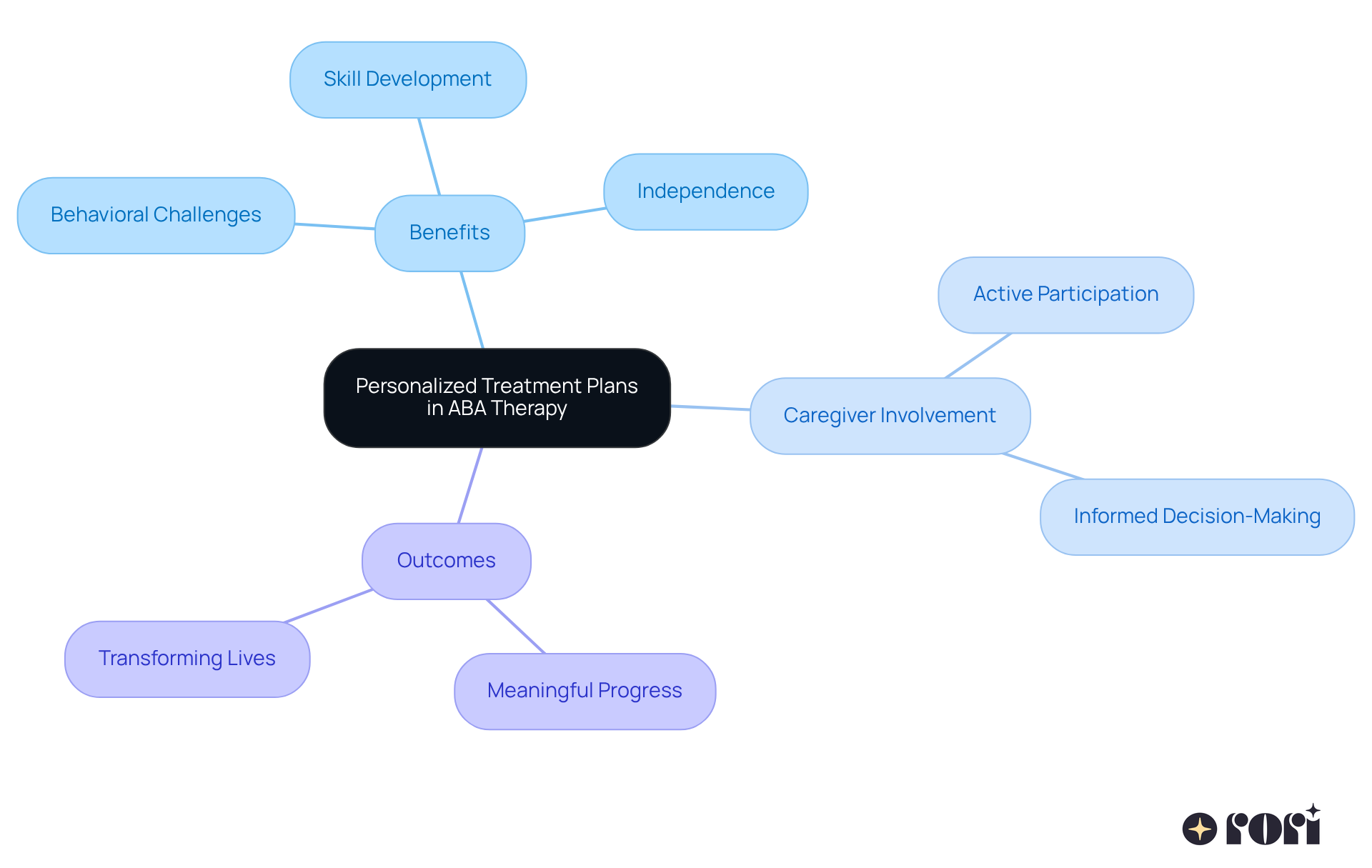
Discrete Trial Training (DTT) is all about breaking down skills into bite-sized pieces and teaching them through repeated practice. Each trial has a clear instruction, a response from the child, and immediate feedback. This structured approach not only helps young learners pick up new skills quickly but also aligns perfectly with the principles of ABA example, which tailors to each child’s unique needs.
When caregivers actively participate, DTT can lead to amazing progress—90% of kids show significant improvement when the recommended hours are fully utilized! This method is particularly beneficial for children who thrive in a consistent learning environment, making it a key part of early intensive behavioral intervention (EIBI). It focuses on boosting education, verbal communication, and social skills in children with autism.
And here’s something important: the ABA example therapy is the only scientifically backed treatment for autism that insurance covers. This really highlights its value in therapeutic interventions.
So, if you’re navigating this journey, remember that you’re not alone. Let’s explore this together! We’re here to help you every step of the way!
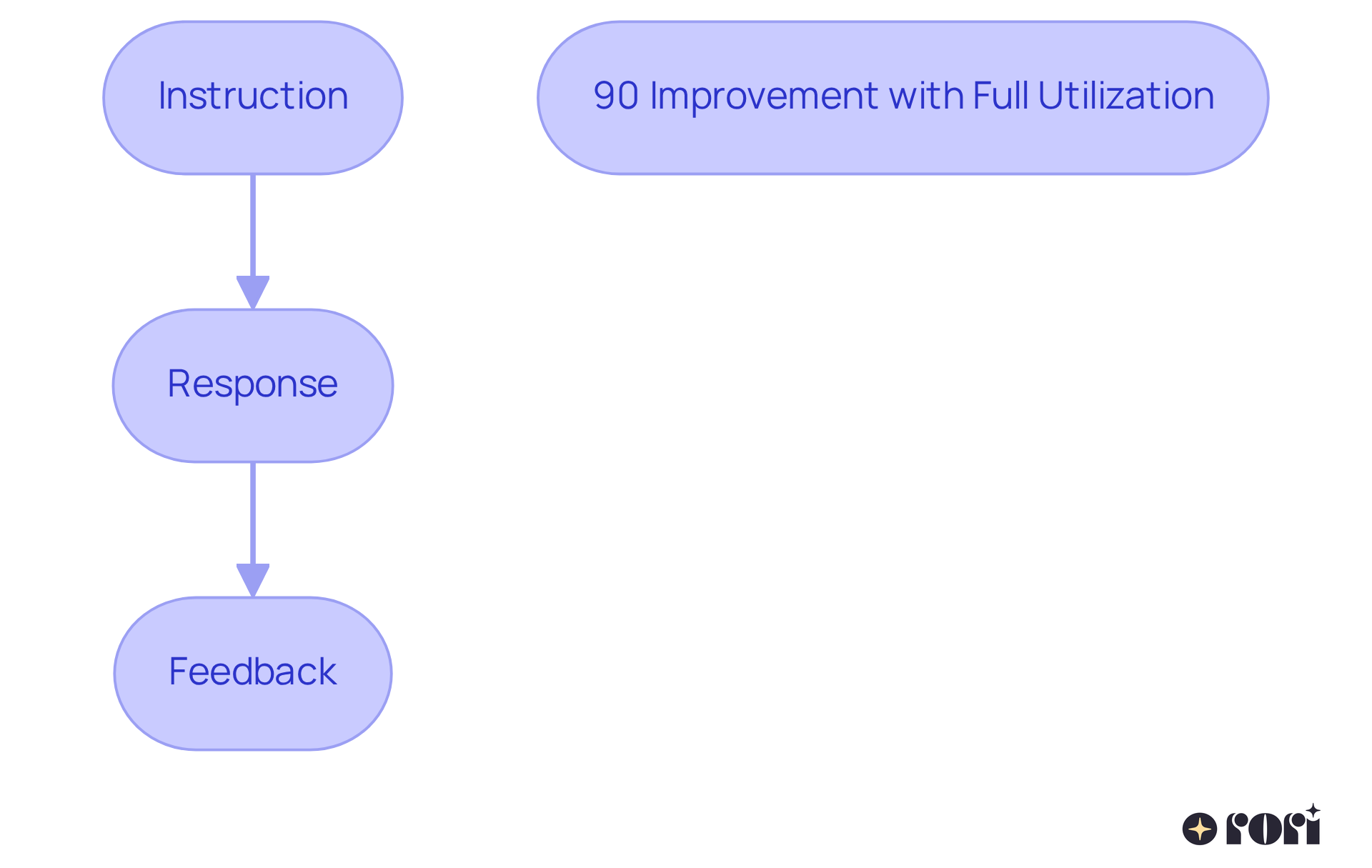
Natural Environment Teaching (NET) really emphasizes the importance of teaching skills through everyday activities, similar to the ABA example. This approach serves as an ABA example that helps kids use what they learn in real-life situations, making it easier for them to remember those skills. By sharing ABA example principles and strategies with caregivers, parents can incorporate educational moments into daily routines—think playtime, family outings, or even grocery shopping!
For instance, while you're at the grocery store, why not ask your kids to help find items on your list? It turns a simple shopping trip into a fun learning experience that boosts their counting and categorization skills. This kind of active involvement not only enhances professional interventions but also serves as an ABA example that helps parents make informed decisions. You’ll find that as you understand how to support your child’s growth better, you’re also creating a richer learning environment.
When education provides an ABA example of relevance and engagement, kids are more likely to internalize their skills and use them in various situations. This fosters their independence and builds confidence. By incorporating NET into daily life, you transform ordinary moments into valuable learning experiences, reinforcing the idea that education goes beyond the classroom. It highlights the importance of experiential learning in a child’s development, leading to better behavioral outcomes and empowered caregivers.
So, let’s explore this together! Remember, every little moment counts!
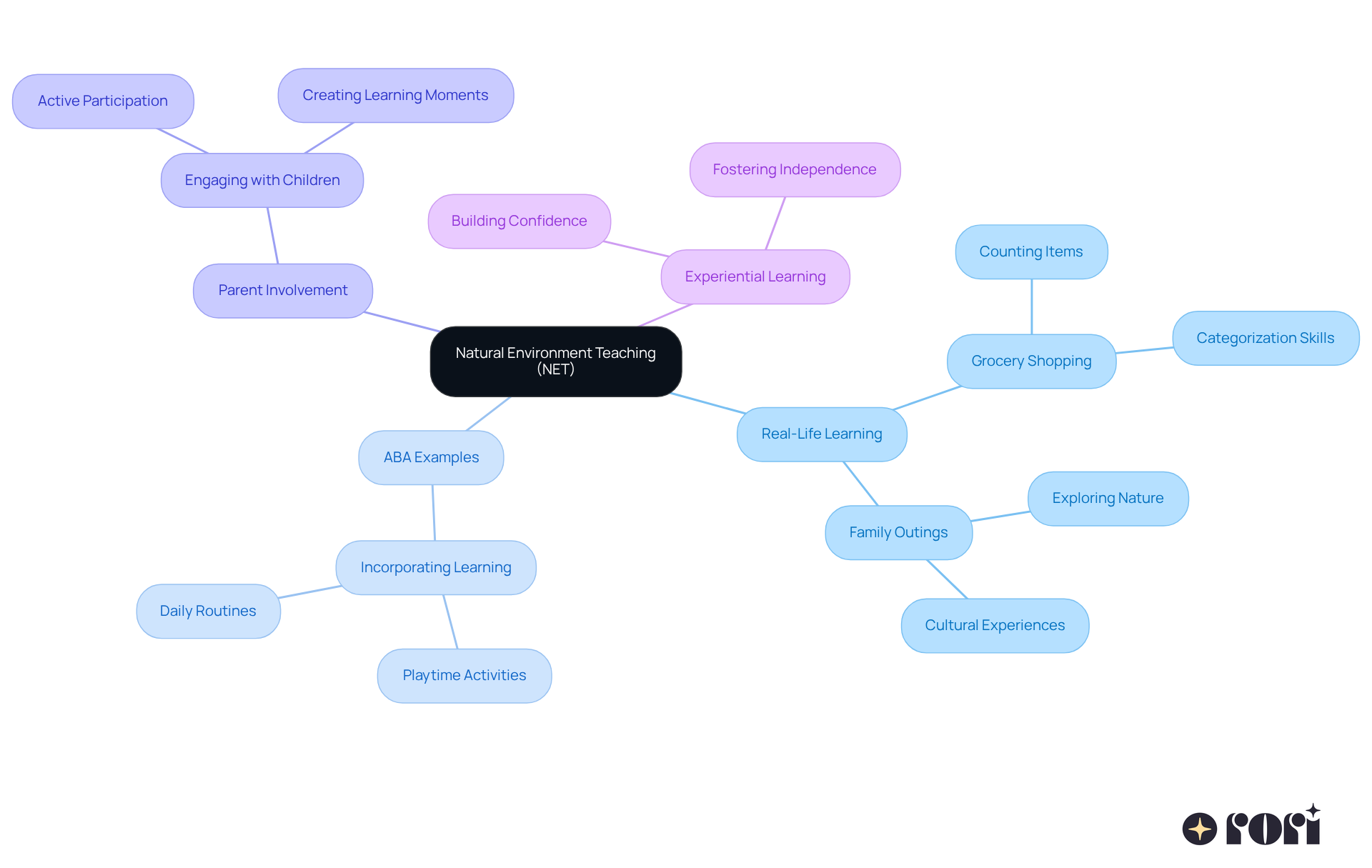
Positive reinforcement is such a powerful tool for parents! It’s all about offering a reward or a kind word right after a child does something great, which really boosts the chances of that behavior happening again. Think about it: when you praise your little one for sharing their toys or finishing their homework, you’re not just making them feel good; you’re encouraging them to keep it up!
There are so many fun ways to reinforce positive behavior. You might use verbal praise, give out stickers, or even offer some extra playtime. When you tailor these rewards to what your child loves, it makes a world of difference in their engagement and learning. For instance, kids who consistently receive positive reinforcement often develop important skills and improve their social interactions.
Now, to really make this work, consistency is key! It’s important for parents to apply the same reinforcement strategies across different situations. This way, your child knows what to expect, and it helps strengthen that bond between you. By celebrating those little wins and providing quick rewards, you’re not just promoting good behavior; you’re also creating a nurturing environment that supports their growth and development.
As Belay On puts it, 'Positive reinforcement is the heart of ABA therapy: It’s how we encourage good behaviors, as shown in an aba example, by giving kids rewards they love.' This really highlights how important it is for caregivers to be educated and empowered to support their child’s development alongside professional help. So, let’s explore this together! By embracing positive reinforcement, you can significantly enhance your child’s learning experience and boost their confidence. We’re here to help you every step of the way!

Task analysis is a fantastic approach in ABA therapy, and an ABA example of this method breaks down complex skills into smaller, manageable steps. This method serves as an ABA example, helping young learners master each part of a task before tackling the whole thing. For instance, when teaching a little one to brush their teeth, you can divide the process into simple steps:
This organized way of learning not only makes it easier but also builds confidence and skills in our young ones.
Research shows just how effective task analysis can be in autism therapy, highlighting its ability to significantly improve skill acquisition. One study even found that it’s especially helpful for individuals with head injuries, showcasing its versatility across different groups. By using this approach, parents can really help their kids learn new skills, ensuring they understand each step along the way.
In real life, task analysis in an ABA example therapy often involves teaching daily living activities, like getting dressed or making a snack. Each task is broken down into clear, actionable steps, allowing learners to move at their own pace. This step-by-step skill building encourages independence and helps young individuals tackle more complex tasks as they grow. Plus, the ongoing assessment process ensures that interventions remain effective and adaptable to each child’s changing needs, promoting lasting positive change. Understanding how the environment shapes actions is key in this learning journey, making task analysis an invaluable tool for parents.
Let’s explore this together! We’re here to help you every step of the way!

Modeling is all about showing young ones the right actions to imitate. Think of it as a way to teach social skills and everyday tasks in a fun, engaging manner. For instance, when parents share toys or use polite language, they’re not just talking; they’re demonstrating behaviors that kids can learn from just by watching.
By consistently showing these positive actions, parents can really help their kids pick up on what’s expected. It’s like giving them a little nudge toward adopting these behaviors themselves. So, let’s explore this together! How can you incorporate modeling into your daily routine?
Imagine a moment when you’re playing with your child. You share a toy, and in that simple act, you’re teaching them about sharing. Or maybe you use kind words when speaking to someone else, showing your child how to communicate respectfully. These small, everyday interactions are powerful learning opportunities!
Remember, it’s all about creating a warm environment where kids feel encouraged to learn. We’re here to help you every step of the way! What are some ways you’ve modeled behavior for your little ones? Share your thoughts!
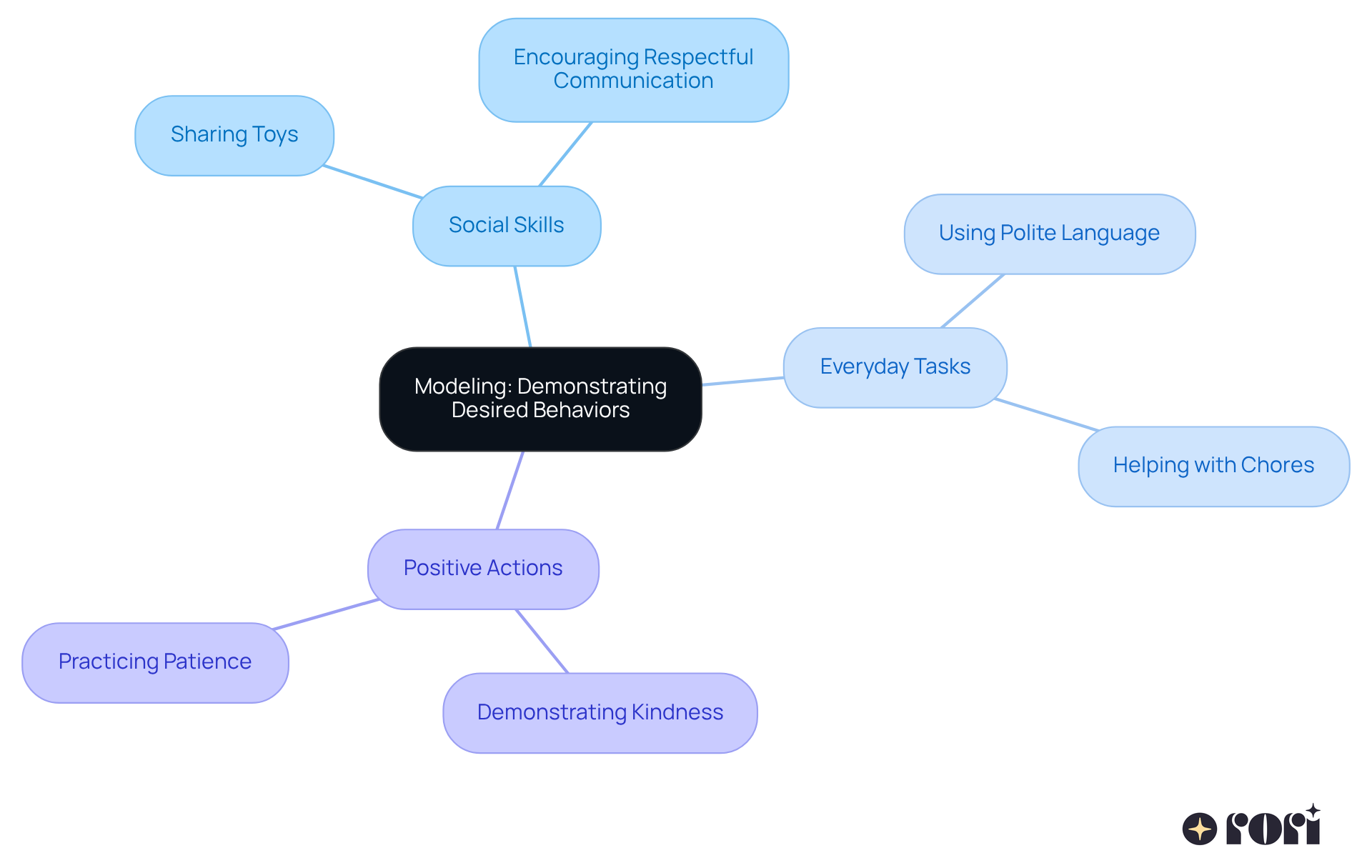
The Picture Exchange Communication System (PECS) is a fantastic tool for non-verbal youth, helping them express their needs and wishes through images. By encouraging kids to swap pictures for items or experiences, PECS not only boosts communication but also reduces frustration. This fosters a sense of independence and enhances social interactions.
Research shows that PECS can significantly improve communication skills, with many children progressing toward more effective speech over time. For instance, one study found that kids using PECS achieved a 100% success rate in their requesting skills after consistent use. That’s pretty impressive, right?
Advocates often share inspiring thoughts, like, "Autism is not a disability; it’s a different ability." This highlights the unique strengths that can shine through when effective communication strategies are in place. At Rori Care, our clinical leadership team is all about empowering caregivers with ABA example principles, ensuring that tools like PECS fit seamlessly into daily life.
Parents can start by creating a simple picture board featuring images of items or activities their child enjoys. This makes it easy for kids to communicate their wants and needs, paving the way for greater social engagement and personal growth. Plus, our team is here to provide ongoing support and strategies to help parents implement PECS effectively, making sure each child’s unique needs are met.
Let’s explore this together! We’re here to help you every step of the way!
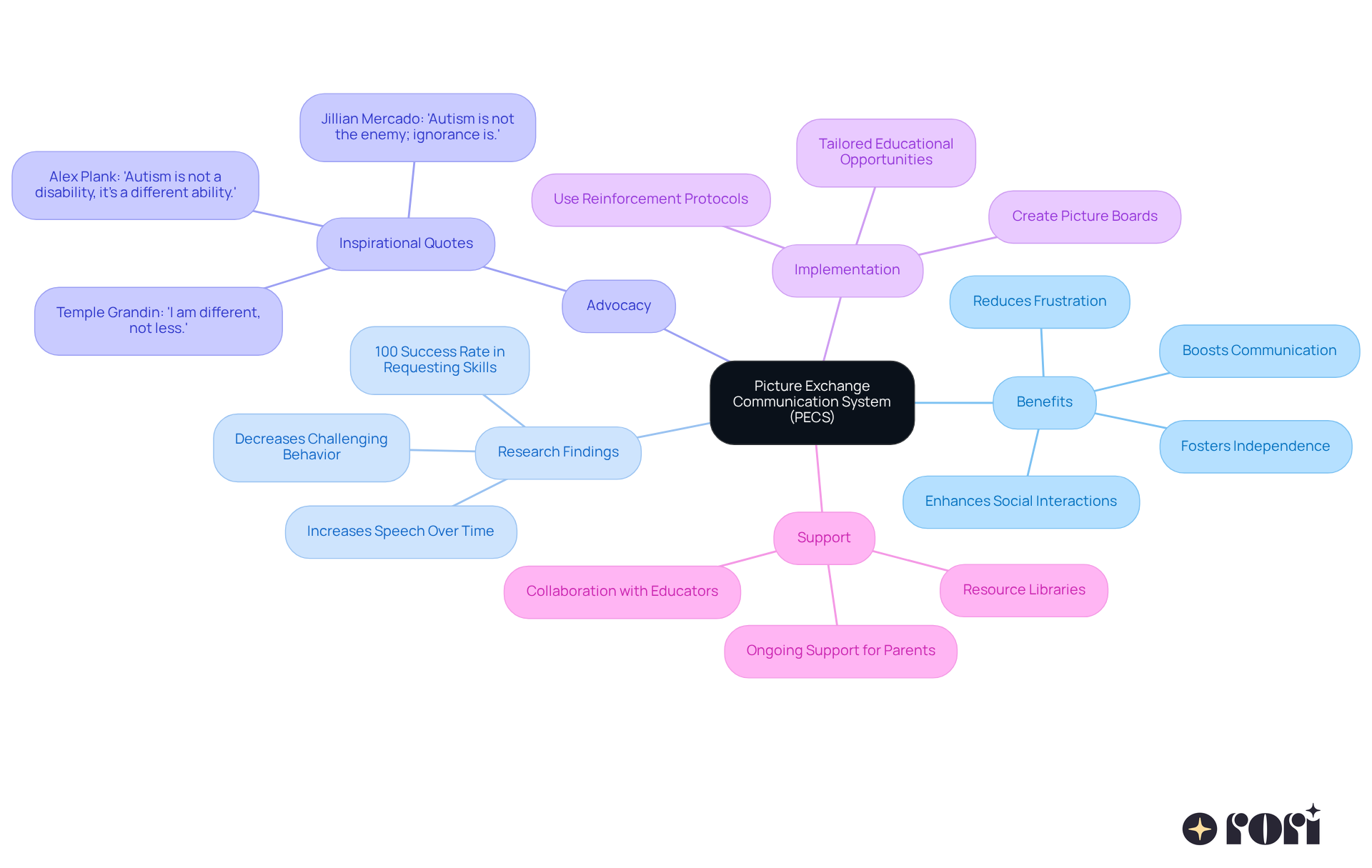
Reinforcement systems can really help parents create a structured way to reward positive actions consistently. Think about token systems, where kids earn tokens for showing preferred behaviors that they can trade for fun rewards. By setting clear expectations and incentives, parents can keep motivation high and inspire their little ones to engage in constructive actions.
But it doesn’t stop there! Providing caregivers with the right knowledge and skills to support their kids' behavioral goals is key. When parents actively get involved and track progress, it can make a world of difference. For example, using charts or apps to monitor behaviors allows caregivers to see how things are going and tweak their strategies as needed. By aligning these practices with the ABA example principles, parents can create a consistent and supportive atmosphere that truly enhances their children's education and growth.
Let’s explore this together! With a little effort and the right tools, you can make a positive impact on your child’s journey.

Errorless education is a friendly teaching approach designed to minimize mistakes, creating a supportive space for skill development. This method serves as an ABA example, rooted in Applied Behavior Analysis (ABA), which tailors therapy based on educational and behavioral science. By providing organized prompts and support, we help young learners respond correctly, significantly lowering the chances of errors. As they gain skills, we gradually reduce prompts, allowing them to build confidence without the fear of failing.
Research shows that using error-free education can really boost children's self-esteem. When we create a flawless learning environment, kids are more likely to engage actively and tackle challenges in their educational journey. This approach not only enhances skill acquisition but also lays a strong foundation of self-worth, as children experience consistent success. This is especially important in early intensive behavioral intervention (EIBI), which aims to improve education, communication, and social skills for children with autism.
In real-life situations, error-free education proves effective across various settings. For example, this technique is often used in ABA therapy to teach communication skills, social interactions, and daily living tasks. When young individuals succeed in their first attempts, they feel a sense of achievement that encourages further exploration and growth.
To bring errorless learning into your home, start by breaking tasks into smaller, manageable steps and providing immediate feedback. This method not only helps kids learn new skills but also boosts their confidence, motivating them to take on new challenges.
Let’s explore this together! By fostering a supportive learning environment, we can help our children thrive.
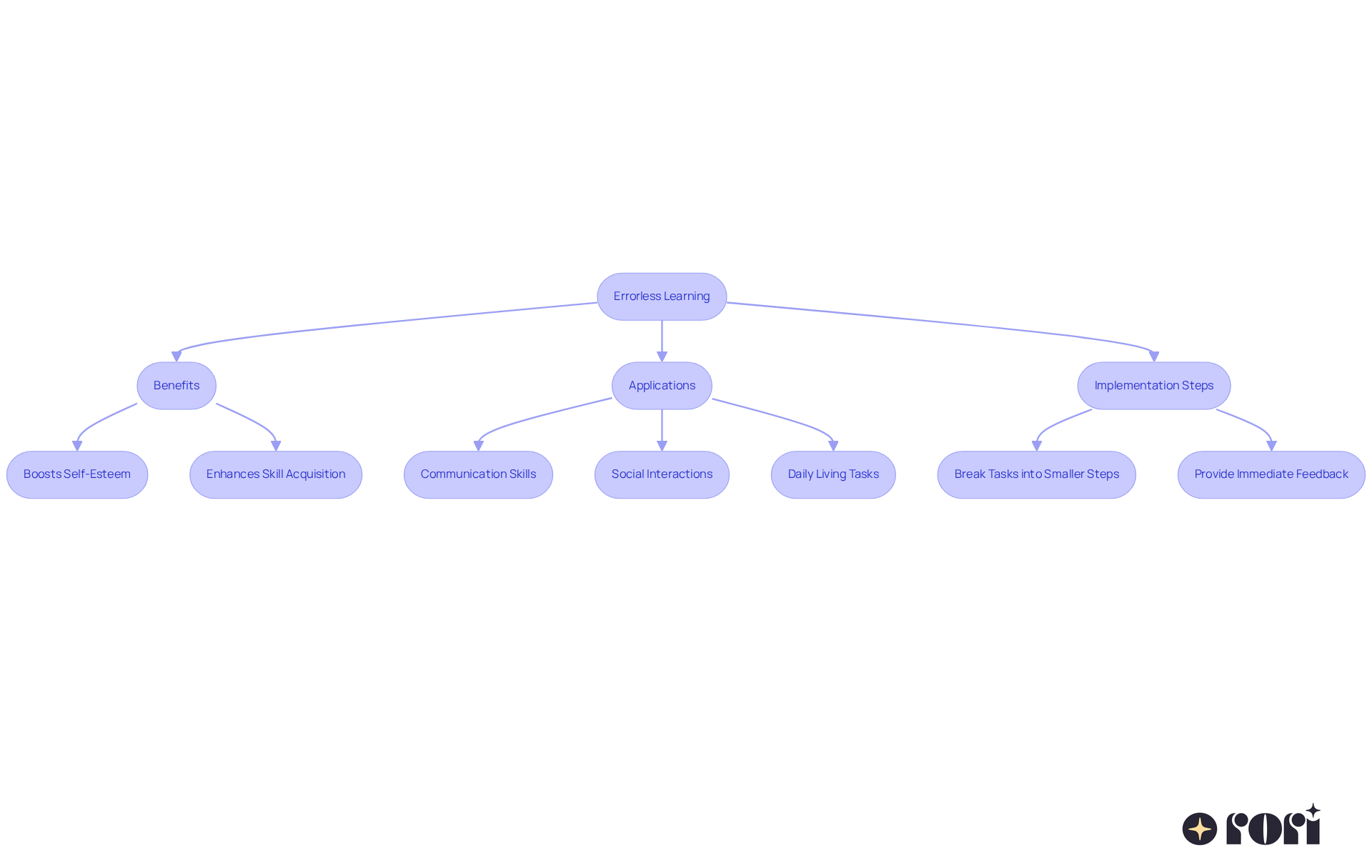
Total task chaining is such a handy method in an ABA example of therapy! It helps teach complex skills by connecting all the steps in one go. Imagine teaching a young person how to make a sandwich—everything from gathering the ingredients to putting it all together can be shown as one smooth task. This way, kids not only see how each step links together but also develop their skills and gain independence.
Research shows that total task chaining really boosts learning outcomes, especially for kids with autism. By presenting the whole series of actions, young learners can better understand the context and purpose of each step, which is super important for mastering daily tasks. Studies have found that this method leads to better retention of skills and helps kids feel more confident doing things on their own.
Plus, using positive reinforcement at every step—like giving verbal praise or small rewards—really encourages kids to get involved in the learning process. This strategy is key for promoting good behaviors and making sure that skills stick around. By using total task chaining, caregivers can really support their child's learning journey. It’s such an important part of effective ABA example therapy!
Let’s explore this together! If you have any thoughts or experiences to share, we’d love to hear from you!

As parents journey through the rewarding yet challenging path of raising a child with autism, understanding essential ABA techniques can truly make a difference. This article has shared ten key ABA examples that empower you to nurture skill development and positive behaviors in your child. By embracing personalized approaches, like those at Rori Care, you can tailor your interventions to meet your child's unique needs, paving the way for meaningful outcomes.
Think about strategies like:
These structured methods can enhance learning and communication in ways that feel natural and engaging. Techniques such as:
help break down complex skills into manageable steps, while tools like the Picture Exchange Communication System (PECS) support effective communication for non-verbal children. Each of these methods highlights the vital role of active parental involvement, which is key to achieving the best results.
As you implement these ABA techniques, you’re not just creating an enriching environment for your child; you’re also fostering their independence and confidence. These strategies go beyond skill acquisition; they reflect your commitment to nurturing your child's potential. By actively engaging in your child's learning journey and utilizing these ABA examples, you can make a lasting impact on their development and overall well-being.
Let’s explore this together! Remember, you’re not alone in this journey. We’re here to help you every step of the way!
What is Rori Care's approach to ABA therapy?
Rori Care believes in personalized treatment plans for ABA therapy, crafted after thorough assessments to meet each child's unique needs. This individualized approach addresses behavioral challenges and fosters skill development and independence.
Why are customized treatment strategies important in autism care?
Research indicates that customized treatment strategies significantly improve outcomes for individuals with autism. Tailoring interventions to fit personal strengths and challenges leads to more meaningful progress, transforming the lives of young people and their families.
How does Rori Care involve parents in the treatment planning process?
Rori Care empowers caregivers by involving them in the treatment planning process, encouraging them to ask how their child’s unique needs will be addressed. This active involvement enhances support and fosters informed decision-making, resulting in better behavioral outcomes.
What is Discrete Trial Training (DTT)?
Discrete Trial Training (DTT) is a structured learning method that breaks down skills into smaller pieces, teaching them through repeated practice. Each trial includes clear instructions, a response from the child, and immediate feedback, helping children acquire new skills quickly.
What are the benefits of DTT for children with autism?
DTT is particularly beneficial for children who thrive in consistent learning environments, leading to significant progress when recommended hours are fully utilized. It focuses on enhancing education, verbal communication, and social skills in children with autism.
Is ABA therapy covered by insurance?
Yes, ABA therapy is the only scientifically backed treatment for autism that is covered by insurance, highlighting its value in therapeutic interventions.
What is Natural Environment Teaching (NET)?
Natural Environment Teaching (NET) emphasizes teaching skills through everyday activities, helping children apply what they learn in real-life situations. This approach allows parents to incorporate educational moments into daily routines.
How can parents incorporate NET into their daily lives?
Parents can turn everyday activities, such as grocery shopping, into learning experiences by involving their children in tasks like finding items on a list. This method boosts counting and categorization skills while enhancing learning opportunities.
What is the significance of experiential learning in a child's development?
Experiential learning, as demonstrated through NET, helps children internalize skills and use them in various situations, fostering independence and building confidence. It reinforces the idea that education extends beyond the classroom, leading to better behavioral outcomes.